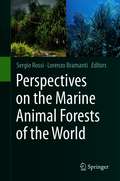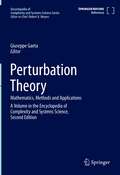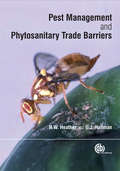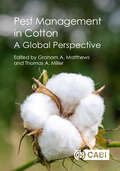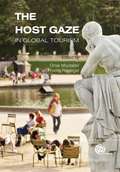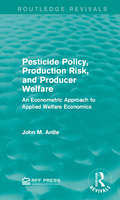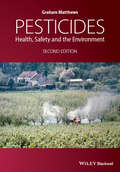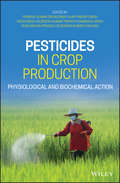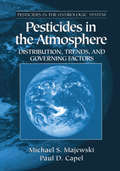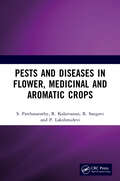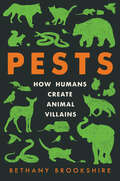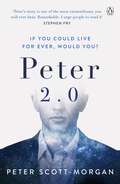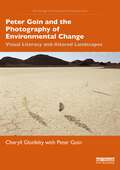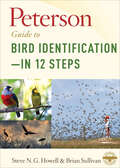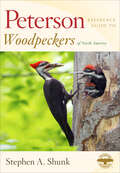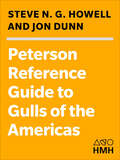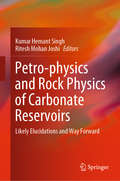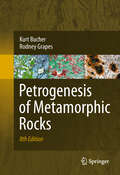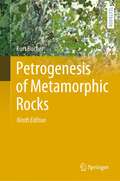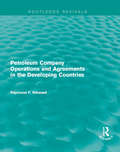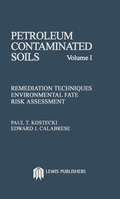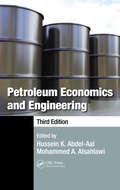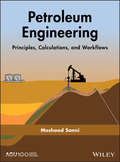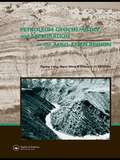- Table View
- List View
Perspectives on the Marine Animal Forests of the World
by Sergio Rossi Lorenzo BramantiMarine Animal Forests (MAFs) are spread all over the world. Composed by suspension feeding organisms (e.g. corals, gorgonians, sponges, bryozoans, bivalves, etc.), MAFs constitute a vast number of marine ecosystems such as coral reefs, cold water corals, sponge grounds, bivalve beds, etc. The surface covered by these systems is prominent (at the scale of the oceans of the planet), though poorly known. In a previous book (Marine Animal Forests, the ecology of benthic biodiversity hotspots), several aspects of the MAFs were described and discussed, building the basis for a holistic approach with the aim of putting these shallow and deep sea ecosystems under a common umbrella. The main target of the present book is to identify and address important topics which were not covered in the previous three volumes. Bryozoans or Polychaeta, for example, are treated in this volume, as well as hydrothermal vents ecosystems and submarine caves, the chemical ecology in MAFs or the nursery effect on these ecosystems. The vastity of the MAF concept opens new insights in the biology, physiology, biodiversity of the organisms structuring these highly biodiverse ecosystems and on the dangers threatening them (such as microplastics or the role of invasive species as an impact of their trophic ecology or distribution). In a fast changing world, in which the complexity of MAFs is at risk, we propose an in-depth analysis of many aspects that may be inspirational for future research lines in marine biology and ecology.
Perturbation Theory: Mathematics, Methods and Applications (Encyclopedia of Complexity and Systems Science Series)
by Giuseppe GaetaThis volume in the Encyclopedia of Complexity and Systems Science, Second Edition, is devoted to the fundamentals of Perturbation Theory (PT) as well as key applications areas such as Classical and Quantum Mechanics, Celestial Mechanics, and Molecular Dynamics. Less traditional fields of application, such as Biological Evolution, are also discussed. Leading scientists in each area of the field provide a comprehensive picture of the landscape and the state of the art, with the specific goal of combining mathematical rigor, explicit computational methods, and relevance to concrete applications. New to this edition are chapters on Water Waves, Rogue Waves, Multiple Scales methods, legged locomotion, Condensed Matter among others, while all other contributions have been revised and updated. Coverage includes the theory of (Poincare’-Birkhoff) Normal Forms, aspects of PT in specific mathematical settings (Hamiltonian, KAM theory, Nekhoroshev theory, and symmetric systems), technical problems arising in PT with solutions, convergence of series expansions, diagrammatic methods, parametric resonance, systems with nilpotent real part, PT for non-smooth systems, and on PT for PDEs [write out this acronym partial differential equations]. Another group of papers is focused specifically on applications to Celestial Mechanics, Quantum Mechanics and the related semiclassical PT, Quantum Bifurcations, Molecular Dynamics, the so-called choreographies in the N-body problem, as well as Evolutionary Theory. Overall, this unique volume serves to demonstrate the wide utility of PT, while creating a foundation for innovations from a new generation of graduate students and professionals in Physics, Mathematics, Mechanics, Engineering and the Biological Sciences.
Pest Management and Phytosanitary Trade Barriers
by Neil W. Heather Guy J. HallmanA significant amount of the world's economy is based upon the international trade of agricultural produce. For the producing countries, a growing concern is the potential economic and ecological damage that invasive species could cause. While threats can be decreased through the regulation of items potentially carrying invasive species, the effect of such restrictions on international trade also needs to be considered. A balance must therefore be met that permits the transfer of produce while filtering out unwanted pests. Drawing on the author's extensive experience, the social and financial implications of phytosanitary trade barriers are reviewed. This book offers valuable and comprehensive coverage of pest related barriers and strategies for their implementation.
Pest Management in Cotton: A Global Perspective
by Zeeshan AhmedThis book presents a global overview of the background to, and the current state of, crop protection and pest management in cotton crops. Cotton is one of the most economically important crops in the world and has been grown for centuries but maintaining high yields of good quality requires sophisticated approaches to pest management. The introduction and use of pesticides over the decades significantly increased cotton yields but lead to many adverse environmental impacts. Over time, new and alternative insecticides were developed but overuse has enabled pests to develop significant resistance. The development of genetically modified cotton varieties with toxins derived from Bacillus thuringiensis enabled much improved control of lepidopteran larvae, including bollworms, but as the toxins had no effect on sucking pests, farmers had no choice but to continue using insecticides. Also, some of the new cotton varieties developed in recent times have not adapted to different climatic conditions and the quality of cotton fibre declined as a result. This book shows the need for more research to select cotton varieties with high quality fibres suitable for different cotton growing areas and to develop integrated pest management strategies to minimise the use of pesticides. It also demonstrates the need for an inter-disciplinary approach bringing together plant breeders, entomologists, plant pathologists, agronomists and agricultural engineers to achieve high yields of high quality cotton. In the future, farmers will need to adopt new technology to determine when and how pesticides are used in conjunction with cultural and biological control strategies. · Emphasises the importance of research on growing cotton in a world experiencing climate change · Demonstrates how crucial crop protection is in achieving high yields of high quality cotton · Shows how new technology will bring major changes in how cotton is grown in the future
Pesticide Encyclopedia
by Vasant Gowariker V N Krishnamurthy Kalyani Paranjape Sudha GowarikerIn today's world, food security is an important issue. Food shortages push prices up, impacting upon the health and well-being of hundreds of millions of rural poor across the globe. One way to increase food security is to decrease the amount of yield lost to pests. The Pesticide Encyclopedia provides a comprehensive overview of the fight against pests, covering chemical pesticides, biocontrol agents and biopesticides. It also covers interrelated topics such as pesticide toxicity, legislation and regulation, handling, storage and safety aspects, IPM techniques, resistance management, interaction of pesticides with soil and the environment. An important reference for policy makers, advisers and students and researchers of crop science, this book also includes useful notes on commonly known plant diseases and pests.
Pesticide Policy, Production Risk, and Producer Welfare: An Econometric Approach to Applied Welfare Economics (Routledge Revivals)
by John M. AntleThe use of pesticides to control agricultural pests both benefits farm production and imposes health and environmental costs on producers and society. This title, first published in 1988, includes an application of the author’s methodology to tomato production, in which Antle illuminates the roles that alternative methods of pest management play in producer welfare. He also develops a more general empirical framework for studying producer welfare under uncertainty – a framework in which production risk, sequential decision making, and attitudes toward risk are integrated. This title will be of interest to students of environmental studies.
Pesticides
by Graham MatthewsCrop protection continues to be an important component of modern farming to maintain food production to feed an expanding human population, but considerable changes have occurred in the regulation of pesticides in Europe in the last decade. The aim has been to reduce their impact on people and the environment. This has resulted in a major reduction in the number of chemicals approved for application on crops. In other parts of the world, a continuing expansion in the growing of genetically modified crops has also changed the pattern of pesticide use. In this second edition, Graham Matthews, updates how pesticides are registered and applied and the techniques used to mitigate their effects in the environment. Information on operator safety, protection of workers in crops treated with pesticides and spray drift affecting those who live in farming areas is also discussed. By bringing together the most recent research on pesticides in a single volume, this book provides a vital up to date resource for agricultural scientists, agronomists, plant scientists, plant pathologists, entomologists, environmental scientists, public health personnel, toxicologists and others working in the agrochemical industry and governments. It should assist development of improvements in harmonising regulation of pesticides in countries with limited resources for registration of pesticides.
Pesticides in Crop Production: Physiological and Biochemical Action
by Prabhat Kumar SrivastavaA guide to the diversity of pesticides used in modern agricultural practices, and the relevant social and environmental issues Pesticides in Crop Production offers an important resource that explores pesticide action in plants; pesticide metabolism in soil microbes, plants and animals; bioaccumulation of pesticides and sensitiveness of microbiome towards pesticides. The authors explore pesticide risk assessment, the development of pesticide resistance in pests, microbial remediation of pesticide intoxicated legumes and pesticide toxicity amelioration in plants by plant hormones. The authors include information on eco-friendly pest management. They review the impact of pesticides on soil microorganism, crops and other plants along with the impact on other organisms like aquatic fauna and terrestrial animals including human beings. The book also contains an analysis of pesticide by GC-MS/MS (Gas Chromatography tandem Mass Spectrometry) a reliable method for the quantification and confirmation of multiclass pesticide residues. This important book: Offers a comprehensive guide to the use of the diversity of pesticides and the pertinent social and environmental issues Explores the impact of pesticides from morphological, anatomical, physiological and biochemical perspectives Shows how pesticides affects soil microorganisms, crops and other plants along with the impact on other organisms like aquatic fauna and animals Critically examines whether chemical pesticides are boon or bane and whether they can be replaced by environmental friendly pesticides Written for students, researchers and professionals in agriculture, botany, entomology and biotechnology, Pesticides in Crop Production examines the effects of chemical pesticides and the feasibility of using bio-pesticides.
Pesticides in the Atmosphere: Distribution, Trends, and Governing Factors
by Michael S. MajewskiMost people know about the presence and health effects of pesticide residues in the water they drink. However, they may not realize the impact of atmospheric transportation and deposition of pesticides on water quality. Scientific studies of pesticides in various atmospheric matrices (air, rain, snow, aerosols, and fog) provide some of the answers.
Pests and Diseases in Flower, Medicinal and Aromatic Crops
by S. Parthasarathy P. Lakshmidevi R. Kalaivanan R. SangaviEffective management of pests and diseases is crucial for the successful and profitable cultivation of crops. To address this need, this book compiles essential information and offers a simple approach to pest, disease, and nematode diagnosis, making it easier for students and non-specialists to tackle the challenges they face in this field. The subject matter details pest management in flower, medicinal and aromatic crops, using different methods and integrated pest management.This book is aimed at students pursuing Agriculture, Horticulture, Botany, Forestry, and Zoology, and non-specialists such as government officials, agricultural workers, horticulturists, extension workers, and professionals in the corporate sector.Print edition not for sale in India.
Pests: How Humans Create Animal Villains
by Bethany BrookshireAn engrossing and revealing study of why we deem certain animals “pests” and others not—from cats to rats, elephants to pigeons—and what this tells us about our own perceptions, beliefs, and actions, as well as our place in the natural worldA squirrel in the garden. A rat in the wall. A pigeon on the street. Humans have spent so much of our history drawing a hard line between human spaces and wild places. When animals pop up where we don’t expect or want them, we respond with fear, rage, or simple annoyance. It’s no longer an animal. It’s a pest.At the intersection of science, history, and narrative journalism, Pests is not a simple call to look closer at our urban ecosystem. It’s not a natural history of the animals we hate. Instead, this book is about us. It’s about what calling an animal a pest says about people, how we live, and what we want. It’s a story about human nature, and how we categorize the animals in our midst, including bears and coyotes, sparrows and snakes. Pet or pest? In many cases, it’s entirely a question of perspective.Bethany Brookshire’s deeply researched and entirely entertaining book will show readers what there is to venerate in vermin, and help them appreciate how these animals have clawed their way to success as we did everything we could to ensure their failure. In the process, we will learn how the pests that annoy us tell us far more about humanity than they do about the animals themselves.
Peter 2.0: The Human Cyborg
by Peter Scott-MorganThe incredible book behind the primetime Channel 4 documentary, Peter: The Human Cyborg'A remarkable account of what it means to be human and what technology can really achieve' Sunday Telegraph'Peter's story is one of the most extraordinary you will ever hear. I urge people to read it' Stephen Fry'A remarkable story . . . you're left desperate to take nothing for granted' Radio Times __________ Peter, a brilliant scientist, is told that he will lose everything he loves. His husband. His family. His friends. His ability to travel the world. All will be gone. But Peter will not give up. He vows that this will not be the end and instead seeks a completely new beginning . . . Peter has Motor Neurone Disease, a condition universally considered by doctors to be terminal. He is told it will destroy his nerve cells and that within about two years, it will take his life too. But, face-to-face with death, he decides there is another way. Using his background in science and technology, he navigates a new path, one that will enable him not just to survive, but to thrive. This is the astonishing true story about Peter Scott-Morgan: the first person to combine his very humanity with artificial intelligence and robotics to become a full Cyborg. His discovery means that his terminal diagnosis is negotiable, something that will rewrite the future.And change the world. By embracing love, life and hope rather than fear, tragedy and despair, he will become Peter 2.0. __________'Compelling . . . Scott-Morgan is a true one-off. It is in the telling of the love story, rather than the technical details of becoming a cyborg, that this book succeeds' The Times 'What's striking is Peter's constant optimism, bravery and his ability to find radical answers to problems that have confounded Britain's brightest minds' Daily Telegraph 'A soaring love story' Financial Times 'Fascinating and extremely moving' Sun
Peter Goin and the Photography of Environmental Change: Visual Literacy and Altered Landscapes (Routledge Environmental Humanities)
by Peter Goin Cheryll GlotfeltyPeter Goin and the Photography of Environmental Change narrates the forty-year quest of award-winning and internationally exhibited contemporary photographer Peter Goin to document human-altered landscapes across America and beyond. It is a collaborative work between an artist and a literary critic, a retrospective of an accomplished environmental photographer, and an innovative education in visual reading. Enduring howling wind, pounding rain, and blistering sun, Goin bears witness to radioactive landscapes, abandoned mines, simulated swamps, rechanneled rivers, controlled burns, overgrown ruins, industrialized agriculture, shrinking reservoirs, feral spaces in the city, architected wilderness, sacred wastelands, contested borderlands, and more. Based on more than seventy hours of taped interviews with the artist spanning over a decade, trailblazing ecocritic Cheryll Glotfelty narrates the arc of Goin's career, sharing excerpts from their conversations that reveal his brilliant mind and piquant personality while situating his work within the broader context of environmental thinkers. This beautifully illustrated volume, with 200 images in color and black-and-white showcasing Goin’s work, will be a fascinating and insightful read for upper-level students, academics, and researchers in photography, environmental history and culture, landscape studies, and environmental humanities.
Peterson Guide To Bird Identification—in 12 Steps (The\crossover Ser.)
by Brian L. Sullivan N. G. Howell&“The birding equivalent of having Albert Einstein and Stephen Hawking teach you how to count, add, subtract, multiply, do long division, comprehend quantum mechanics, plus balance your checkbook. Bird watchers at every skill level will garner insights from this book.&” — Pete Dunne, author of Birds of Prey &“Identifying birds is a science and an art, involving far more than merely memorizing field marks. Steve Howell and Brian Sullivan are leading masters of this craft, and they share a wealth of inside knowledge in this gem of a book. If you're a birder at any level of experience, from beginner to expert, read this book from cover to cover and I guarantee it will improve your skills in the field.&” — Kenn Kaufman, author of the Kaufman Field Guide to Advanced Birding &“ . . . if you are going to have a book-based conversation with bird experts about identification, Howell and Sullivan are going to be at the top of the list. . . . [The Peterson Guide to Bird Identification—In 12 Steps] is a highly opinionated book reflecting the approach and thoughts of the authors. Which is exactly what makes it a book that all birders should read, consult, and maybe even, like me, read again.&” — Donna Schulman, 10,000 Birds.com &“This book is friendly, non-intimidating, and even humorous. New birders can acquire some basics from this handy little book, and experienced birders can pick up some vital pointers, especially useful when helping the uninitiated. . . . Basically, there is something in this short book for every birder, and the 152 pages present many opportunities for all birders to pick out and explore what that &‘something&’ may be.&” —Paul J. Baicich and Wayne Petersen, Birding Community E-bulletin —
Peterson Reference Guide To Woodpeckers of North America (Peterson Field Guides)
by Stephen ShunkA complete guide to the natural history, ecology, and conservation of North America’s twenty-three woodpecker species.From the iconic Woody Woodpecker to the ubiquitous Northern Flicker, woodpeckers have long captivated our attention. Their astonishing anatomy makes them one of the most specialized bird families in the world, and their keystone ecological roles in our forests and woodlands makes them some of the most important birds on the continent.This comprehensive and authoritative guide to the natural history, ecology, and conservation of North America’s twenty-three woodpecker species goes far beyond identification. It explores their unique anatomy and their fascinating and often comical behaviors; it covers each species’ North American conservation status; and it showcases over 250 stunning photographs of woodpeckers in their natural habitats, plus easy-to-read figures and range maps. This reference guide is an essential addition to every birder’s library.
Peterson Reference Guides To Gulls of The Americas (Peterson Reference Guides)
by Jon Dunn N. G. HowellThis ambitious volume covers the 36 species of gulls that occur in North and South America, with detailed information to help you identify these fascinating but challenging birds in their many and varied plumages. With 1,160 carefully chosen color photographs, this new reference guide, written by two of North America's top gull experts, is the definitive new work on gulls of the Americas.Peterson Reference Guides offer authoritative, comprehensive information, including detailed text, maps, and superior illustrations. Written by expert authors, the guides are an unparalleled resource for understanding specific groups of animals.
Peterson's First Guide to Seashores
by John KricherPeterson First Guides are the first books the beginning naturalist needs. Simplified versions of the famous Peterson Field Guides, the First Guides focus on the animals, plants, and other things you are most likely to see. They make it easy to get started in the field-and easy to graduate to the full-fledged Peterson Guides.
Petro-physics and Rock Physics of Carbonate Reservoirs: Likely Elucidations and Way Forward
by Kumar Hemant Singh Ritesh Mohan JoshiThis book presents selected articles from the workshop on "Challenges in Petrophysical Evaluation and Rock Physics Modeling of Carbonate Reservoirs" held at IIT Bombay in November 2017. The articles included explore the challenges associated with using well-log data, core data analysis, and their integration in the qualitative and quantitative assessment of petrophysical and elastic properties in carbonate reservoirs. The book also discusses the recent trends and advances in the area of research and development of carbonate reservoir characterization, both in industry and academia. Further, it addresses the challenging concept of porosity portioning, which has huge implications for exploration and development success in these complex reservoirs, enabling readers to understand the varying orders of deposition and diagenesis and also to model the flow and elastic properties.
Petrogenesis of Metamorphic Rocks
by Rodney Grapes Kurt BucherPetrogenesis of Metamorphic Rocks presents a large number of diagrams showing the stability relations among minerals and groups of minerals found in metamorphic rocks. The diagrams help to determine the pressure and temperature conditions under which a given set of metamorphic rocks may have formed. Other parameters that control metamorphic mineral assemblages are also discussed and pitfalls resulting from simplifications and generalizations are highlighted. The book discusses the most common metamorphic rock types, their nomenclature, structure and graphical representation of their mineral assemblages. Part I defines basic principles of metamorphism, introduces metamorphic processes, geologic thermometry and barometry and defines metamorphic grade. Part II presents in a systematic way mineralogical changes and assemblages found in the most common types of metamorphic rocks. The computation of diagrams is based on recent advances in quantitative petrology and geochemistry. An extensive bibliography, including the key contributions and classic papers in the field, make it an invaluable source book for graduate students and professional geologists.
Petrogenesis of Metamorphic Rocks (Springer Textbooks in Earth Sciences, Geography and Environment)
by Kurt BucherThis new edition of the classic textbook presents a large number of diagrams showing the stability relations among minerals and groups of minerals found in metamorphic rocks. The diagrams help to determine the pressure and temperature conditions under which a given set of metamorphic rocks may have formed. Other parameters that control metamorphic mineral assemblages are also discussed and pitfalls resulting from simplifications and generalizations are highlighted. The book discusses the most common metamorphic rock types, their nomenclature, structure and graphical representation of their mineral assemblages. Part I defines basic principles of metamorphism, introduces metamorphic processes, geologic thermometry and barometry and defines metamorphic grade. Part II presents in a systematic way mineralogical changes and assemblages found in the most common types of metamorphic rocks. The computation of diagrams is based on recent advances in quantitative petrology and geochemistry. An extensive bibliography, including the key contributions and classic papers in the field, make it an invaluable source book for graduate students and professional geologists.
Petroleum Company Operations and Agreements in the Developing Countries (Routledge Revivals)
by Raymond F. MikesellOriginally published in 1984, this study focuses on petroleum agreements between non-OPEC LDCs with oil-importing LDCs and how issues such as high oil prices affect each country. The information presented in this study was drawn from interviews with petroleum officials in petroleum companies, petroleum ministries and unpublished documents such as contracts and focussing on case studies of countries such as Peru, Guatemala and Malaysia. This title will be of interest to students of environmental studies and economics.
Petroleum Contaminated Soils, Volume I: Remediation Techniques, Environmental Fate, and Risk Assessment
by Paul T. KosteckiThese three volumes provide valuable information to help bring rational and scientifically feasible solutions to petroleum contaminated soils. State-of-the-art information on both technical and regulatory issues is covered, including environmental fate, health effects, risk assessment and remedial alternatives. They show why petroleum contaminated soils are a problem - and propose solutions for that problem. These books are an excellent reference for regulatory personnel and environmental consultants at all levels.
Petroleum Economics and Engineering
by Mohammed A. Alsahlawi Hussein K. Abdel-AalThis book explains how to apply economic analysis to the evaluation of engineering challenges in the petroleum industry. Discussion progresses from an introduction to the industry, through principles and techniques of engineering economics, to the application of economic methods. Packed with real-world examples and case studies demonstrating how to
Petroleum Engineering: Principles, Calculations And Workflows (Geophysical Monograph Series #237)
by Moshood SanniA comprehensive and practical guide to methods for solving complex petroleum engineering problems Petroleum engineering is guided by overarching scientific and mathematical principles, but there is sometimes a gap between theoretical knowledge and practical application. Petroleum Engineering: Principles, Calculations, and Workflows presents methods for solving a wide range of real-world petroleum engineering problems. Each chapter deals with a specific issue, and includes formulae that help explain primary principles of the problem before providing an easy to follow, practical application. Volume highlights include: A robust, integrated approach to solving inverse problems In-depth exploration of workflows with model and parameter validation Simple approaches to solving complex mathematical problems Complex calculations that can be easily implemented with simple methods Overview of key approaches required for software and application development Formulae and model guidance for diagnosis, initial modeling of parameters, and simulation and regression Petroleum Engineering: Principles, Calculations, and Workflows is a valuable and practical resource to a wide community of geoscientists, earth scientists, exploration geologists, and engineers. This accessible guide is also well-suited for graduate and postgraduate students, consultants, software developers, and professionals as an authoritative reference for day-to-day petroleum engineering problem solving.
Petroleum Geochemistry and Exploration in the Afro-Asian Region: Proceedings of the 6th AAAPG International Conference, Beijing, China, 12-14 October 2004
by Digang Liang Darui Wang Zhenxi LiPetroleum Geochemistry and Exploration in the Afro-Asian Region includes 29 papers presented at the 6th International Conference on Petroleum Geochemistry and Exploration in the Afro-Asian Region.Petroleum geochemistry has played a crucial role in determining effective source rocks, classifying petroleum systems and delineating the geneses of conve
